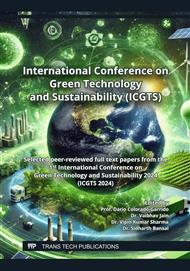[1]
L. W. Ripa and G. S. Leske, "Longitudinal study of the caries susceptibility of occlusal and proximal surfaces of first permanent molars," J Public Health Dent, vol. 48(1), pp.8-13, 1988.
DOI: 10.1111/j.1752-7325.1988.tb03154.x
Google Scholar
[2]
J. W. Nicholson, "Titanium alloys for dental implants: A Review," Prosthesis, vol. 2, no. 2, Prosthesis, p.100–116, 2020.
DOI: 10.3390/prosthesis2020011
Google Scholar
[3]
J. Joshi, N. Gariya, A. R. Manral, and P. Kumar, "Comparative analysis of a human tooth using different materials based on the finite element method," Materials Today: Proceedings, p.94–98, 2020.
DOI: 10.1016/j.matpr.2020.06.021
Google Scholar
[4]
F. Zarone, M. I. Di Mauro, P. Ausiello, G. Ruggiero, and R. Sorrentino, "Current status on lithium disilicate and zirconia: A narrative review," BMC Oral Health, vol. 19, no. 1, pp.1-14, 2019.
DOI: 10.1186/s12903-019-0838-x
Google Scholar
[5]
Ioannis K. Karoussis, Urs Brägger, Giovanni E. Salvi, Walter Bürgin, Niklaus P. Lang "Effect of implant design on survival and success rates of titanium oral implants: A 10-year prospective cohort study of the ITI(R) dental implant system," Clinical Oral Implants Research ,vol.15(1), pp.8-17, 2004.
DOI: 10.1111/j.1600-0501.2004.00983.x
Google Scholar
[6]
Cionca, N., Hashim, D., Mombelli, A., Zirconia dental implants: where are we now, and where are we heading?, Periodontology, vol. 73(1), pp.241-258, 2017.
DOI: 10.1111/prd.12180
Google Scholar
[7]
P. Baldissara, A. Llukacej, L. Ciocca, F. L. Valandro, and R. Scotti, "Translucency of zirconia copings made with different CAD/CAM systems," Journal of Prosthetic Dentistry, vol. 104, no. 1, p.6–12, Jul. 2010.
DOI: 10.1016/S0022-3913(10)60086-8
Google Scholar
[8]
A. V. Tibau, B. D. Grube, B. J. Velez, V. M. Vega, and J. Mutter, "Titanium exposure and human health," Oral Science International. John Wiley and Sons Inc., 2019.
DOI: 10.1002/osi2.1001
Google Scholar
[9]
J. Singh and A. Kohli, "Stress analysis of second molar tooth," Comput Aided Des Appl, vol. 10, no. 4, p.701–709, 2013.
DOI: 10.3722/cadaps.2013.701-709
Google Scholar
[10]
R. Biswas and R. C. Strawn, "Tetrahedral and hexahedral mesh adaptation for CFD problems," Applied Numerical Mathematics, vol. 26, Issues 1–2, pp.135-151, 1998.
DOI: 10.1016/S0168-9274(97)00092-5
Google Scholar
[11]
C. Âudio, P. Fernandes, J. Glantz, S. A. Svensson, and A. Bergmark, "A novel sensor for bite force determinations," Dental Materials, vol. 19, No.2, pp.118-126, 2003.
DOI: 10.1016/S0109-5641(02)00020-9
Google Scholar
[12]
P. Shelar, S. Butler, and H. Abdolvand, "On the behaviour of zirconia-based dental materials: A review," Journal of the Mechanical Behavior of Biomedical Materials, vol. 124. Elsevier Ltd, Dec. 01, 2021.
DOI: 10.1016/j.jmbbm.2021.104861
Google Scholar
[13]
A. Pérez-González, J. L. Iserte-Vilar, and C. González-Lluch, "Interpreting finite element results for brittle materials in endodontic restorations," Biomed Eng Online, vol. 10, pp.1-16, June 2011.
DOI: 10.1186/1475-925X-10-44
Google Scholar


